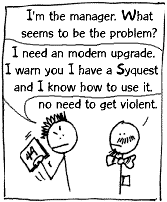Development
Huyler grew up in Winnetka, Illinois as the oldest of three brothers. Bored throughout high school, he skipped college and in 1988 started an electronic graphics business with his father. The company the two created folded up within a year, however, and the NetBoy concept was slowly forming while Huyler worked as a pizza deliverer and programmed digital keyboards for musicians. [2]
Huyler started uploading NetBoy on the World Wide Web when he was 23 years old and worked as a creative director for Chicago-based internet provider InterAccess. The stick figure character was designed as an "Internet innocent" because, as Huyler put it at the time, "the Internet needs a good parody." According to Huyler, each of the characters in the webcomic are based on people one may find on the internet. Huyler started selling NetBoy T-shirts within a year of the webcomic's release. [3] When NetBoy was accessed by six users every second in December 1994, the server it was hosted on crashed, which prompted Huyler to go on hiatus for three months so that he could design a server that could better serve the rising demands. In March 1995, Huyler estimated NetBoy's following to be at 1 million people. [2]
This page is based on this
Wikipedia article Text is available under the
CC BY-SA 4.0 license; additional terms may apply.
Images, videos and audio are available under their respective licenses.
